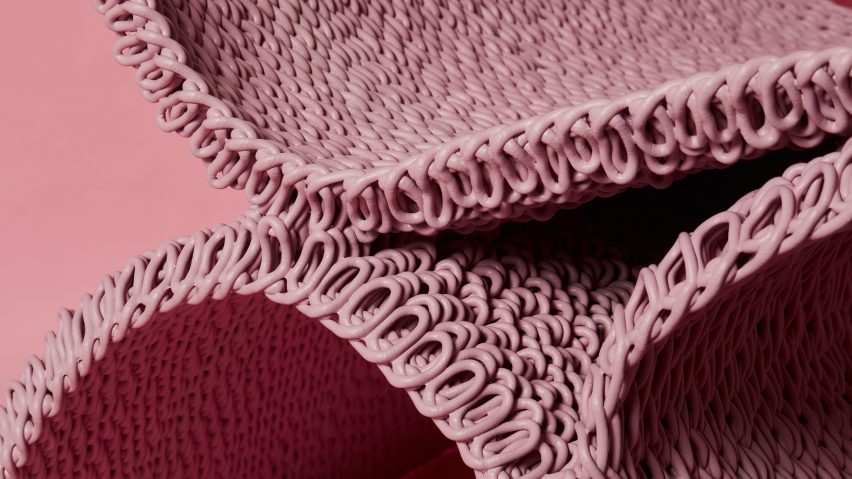British designer Gareth Neal and Dutch studio The New Raw have used thrice-recycled plastic and a new 3D-printing method to create the objects in the Digitally Woven series, which are printed in loops rather than layers.
The designer and the studio displayed several of their creations — a pink chair called Loopy and three vessels with a look reminiscent of woven baskets — at the Material Matters fair during the London Design Festival.
Neal is known for making furniture that references or incorporates heritage crafts and usually works in wood, while The New Raw specialises in robotic manufacturing with plastic waste.
The collaborators paired up with the goal of exploring how traditional craft techniques such as willow work, knitting, crocheting and paper-cord weaving could inform a new style of 3D printing.
They hoped to develop a method that would allow for imperfections in the final product and therefore reduce the amount of waste due to misprints.
For Digitally Woven, Neal and The New Raw created objects using various patterns of interlocking loops, which gave the structures strength and enabled the makers to use three-times recycled plastic, a rarely used material.
Currently, when working with recycled polypropylene plastic filament in 3D printing, the mix of source materials in the waste stream and the number of times it has been recycled are factors that can make it more unstable.
However, Neal and The New Raw's technique is visibly different from typical 3D printing, where the filament is added in layers to build an object.
Here, the printing robot has extruded thicker cords of material, almost like icing from a piping bag, laying it down in a looped pattern in 3D space.
According to Neal, the print lines for the machine are based on ones drawn by hand, creating a nuanced look informed by natural movement and crafting tools.
"At the time of starting the project, The New Raw was printing in a very traditional style with layered prints that had come from putting 3D models through slicer tools," Neal told Dezeen.
"They asked me to look into how we could consider using their technology to capture craft techniques that they had started to explore to disguise the misprints," he added.
Their experimentation yielded a "massive amount" of samples and textures, said Neal.
"The open weave structures were a totally new breakthrough and are really quite special in that they create structurally strong, lightweight objects using half the normal material use," he continued.
The designer said the project, which had been funded by a European Union grant, had involved a steep learning curve for him, as he had rarely used additive manufacturing and never worked with plastic.
"I learned so much," said Neal. "It has also reinforced how important the close relationship is between artists and manufacturers. If a manufacturer is open to experimentation, a designer or a maker really can introduce new approaches to traditional methods."
Neal is now working to expand and refine the range of Digitally Woven products. He says the Loopy chair can be made to order in any colour, using plastic from any waste stream.
Neal's previous work has included picnic furniture made with marquetry and a CNC-machined but 1780s-inspired chest of drawers that is in the collection of the V&A.
The New Raw's projects include the Ermis chair, a monobloc seat made from its own 3D-printing waste.
The photography is by James Champion.

